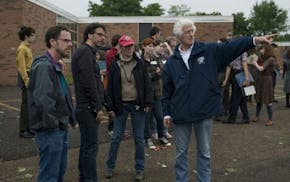The intricacies of the human body in motion -- muscles flexing, joints hinging, cells powering a system of anatomical thrust -- represent a feat of cosmic proportion, a biological achievement where Newtonian laws and the limits of locomotion mix to move a beating, breathing form through space and time. Some people just call it running.
On a treadmill a few weeks ago in Boulder, Colo., I paced alone in the audience of an exercise physiologist as a runner long on a quest for the perfect stride. Like many casual runners, I have worked to refine my technique and running style. I train with a heart-rate monitor and know the type of shoe that fits my foot.
But despite training thousands of hours over the years and completing a half-dozen marathons, I have never sought more than basic advice on my body's method for plodding forward on a plane.
Thus the test in Boulder.
The procedure, a $350 gait analysis at the Boulder Center for Sports Medicine, involved a clinical exam, stop-motion video and software that calculated angulations in my hips, ankles and knees. My assessor, Tim Hilden, a physical therapist and a native Minnesotan, mixed a thorough medical evaluation with time spent observing me sweat and run on a treadmill.
"This test gives amateur athletes the type of treatment often reserved for the pros," Hilden said.
Basic gait-analysis tests are offered free at running shops nationwide, including in the Twin Cities. Run on a treadmill at a store such as StartLine in Minnetonka, and a salesperson can see from your stride which type of shoe you should wear.
"We watch your stride and listen to the sound of the shoe as you run," said Monica Wenmark, StartLine's owner.
At TC Running Co. in Eden Prairie, Kurt Decker asks to see customers' used shoes to discern patterns on the tread, which reveal stride habits.
"Wear on the sole never lies," he said.
The Boulder Center's test, administered in a facility customized for sports medicine and athletic rehabilitation, adds a complexity not possible in a running shop. My evaluation began in an exam room, where Hilden performed strength tests and surveyed me on running habits.
He scribbled notes as we walked a few hundred feet down a hall toward a lab. Inside, a video camera was aimed at a treadmill, ready to capture my stride to the fraction of a second.
"Take a couple of minutes to get your pace," Hilden said, motioning toward the machine.
I came to Boulder with no outright issue. Unlike many test takers, I was injury-free and for the most part content with my technique. But the chance to become a better runner was alluring.
Hilden said many clients come with knee troubles, foot ailments such as plantar fasciitis, or Achilles tendon problems. His test offers clinical conclusions for runners who might have long suffered with compromised form.
On the treadmill, I started slow, then kicked up to a 6:45-mile pace.
Hilden and an assistant aimed lights and camera my way and launched a software program to analyze my stride.
In less than five minutes, Hilden had me jump off and come over to a monitor. He slowed the video, and each subtle motion of my feet, ankles, knees, hips and back became discernible on the screen.
"Look at your hip angle," Hilden said, tracing a line on the monitor's glass. His assistant annotated on a computer, measurements and angles popping onscreen. "Too much motion in that hip," Hilden said.
The test quantified my feet's pronation, or the amount of inward roll, which measured 7.3 degrees with my right foot and 8.2 degrees for the left. My arm position was fine, he said. But I was leaning too far forward. My stance width was too narrow on some strides.
I tried inserts and different shoes to better correct the pronation.
Hilden measured the angles again, the stop-motion video letting him see my foot interact with varying shoe types.
After an hour of tests, my diagnosis was nothing dramatic. Hilden said my gait was good overall, although a few tweaks might improve efficiency and lessen wear and tear to keep me running longer.
He said my off-the-shelf footwear prescription is a stability shoe, which is the same recommendation a running shop had given me -- for free -- after two minutes on a treadmill.
But I left Boulder with in-depth knowledge of how I run. I also went away with a four-week plan on correcting subtle technique issues to improve my gait. In the quest for the perfect stride, every little thing counts.
Stephen Regenold writes on fitness and the outdoors at www.gearjunkie.com.

Meet the Oscar-winning cinematographer who has changed the way the movies look
An Algerian reporter says he was expelled from his country without explanation

A former deli maestro steps into Capt. von Trapp's shoes in Artistry's 'Sound of Music'

NPG vets Michael Bland and Sonny Thompson extend their brotherhood into a post-Prince duo
